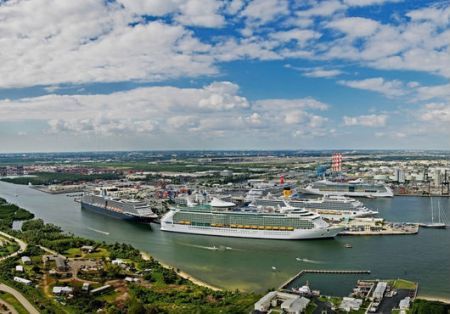
The Broward County Board of County Commissioners, which governs the Port as a self-funded enterprise fund, approved the Port Everglades 2014 Master/Vision Plan on June 24th during its regularly scheduled meeting. Over the past year, Port staff and maritime consultant AECOM Technical Services, Inc. held more than 20 meetings with customers, stakeholders and the general public to develop the Plan.
“This is the second update to the original Master/Vision Plan that was adopted in 2006. At that time, the Commission directed staff to update the plan every two to three years to take a hard look at market trends and how we could maximize existing facilities to ensure that Port Everglades continues to be an economic powerhouse,” said Port Everglades Chief Executive & Port Director Steve Cernak.
Market Forecast
Market assessments, critical to identifying the Port’s future infrastructure needs, predict steady growth in all business sectors at Port Everglades.
The cruise business at Port Everglades is forecasted to reach 5.6 million passenger moves in 2033 compared to 4 million expected during fiscal year 2014 (ending September 30, 2014).
Port Everglades is expected to continue as Florida’s leading containerized cargo port, reaching 1.7 million TEUs (the industry standard measurement of 20-foot equivalent units) in 2033 compared to 943,000 TEUs expected during FY2014. Non-containerized cargo such as steel, lumber, aggregate, cement and vehicles is forecasted to reach nearly 3.3 million tons by 2033, which is triple the amount moved through Port Everglades today.
Petroleum products, especially gasoline and jet fuel, which are moved by ship and rail to private petroleum terminals inside the Port, are also anticipated to increase as South Florida’s consumer population continues to grow. Total volumes are projected to grow from 300,000 barrels daily to 376,000 barrels daily in 2033, with jet fuel replacing gasoline as the top petroleum commodity moving through the Port.
Infrastructure Highlights
Current keystone capital improvements are providing a springboard for future growth and infrastructure enhancements. Those current projects include lengthening the Southport Turning Notch from 900 to 2,400 feet to add up to five new cargo berths; deepening and widening the navigation channels; and, opening this July, the Florida East Coast Railway’s new intermodal container transfer facility (ICTF).
Projects in the five-year Master Plan include:
Longer-term projects in the 10- and 20-year Vision Plans include:
The plan also includes conducting traffic and environmental studies for projects in the five-year Master Plan, and an affordability analysis for the projects in the 10-year timeframe.
We use cookies to improve your experience. By continuing to use our site, you accept our Cookies, Privacy Policy,Terms and Conditions. Close X